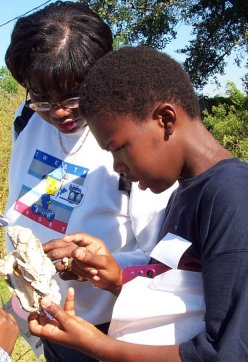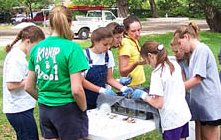Living Classrooms
Overview: Oyster Habitats as Living Classrooms
 During the summer of 2001, twelve teachers from the greater Charleston, South Carolina area participated in a professional development workshop for teachers of grades 5 through 12 called Oyster Habitats as Living Classrooms. This workshop was jointly sponsored by the South Carolina Department of Natural Resources (SCDNR) and the Charleston Math & Science Hub.
During the summer of 2001, twelve teachers from the greater Charleston, South Carolina area participated in a professional development workshop for teachers of grades 5 through 12 called Oyster Habitats as Living Classrooms. This workshop was jointly sponsored by the South Carolina Department of Natural Resources (SCDNR) and the Charleston Math & Science Hub.
Participating teachers reviewed oyster biology and ecology through hands-on activities. They learned how oyster habitats are being restored in South Carolina through the SCORE program and explored opportunities for using the restored reefs to introduce biology, geology, chemistry, mathematics, and environmental science to their students. Working in grade-specific teams, the teachers developed field and classroom activities/lesson plans in accordance with South Carolina Standards for Math and Science. Teachers can read about these lesson plans below for ideas to implement in their classrooms. Please contact The SCORE Program (843-953-9842) at SCDNR for more information about the teacher workshop or the lesson plans.
Schools that are participating in the SCORE program through development of educational activities and/or restoration and monitoring of reefs include the following:
| Ashley Hall | Archibald Rutledge Academy |
| Academic Magnet School | Beaufort Marine Institute |
| Bishop England High School | Charleston Progressive School |
| Hanahan Middle School | Hanahan High School |
| James Island High School | James Island Middle School |
| Mason Preparatory School | Moultrie Middle School |
| Newington Elementary School | North Charleston High School |
| Palmetto Christian Academy | Pinewood Preparatory School |
| Port Royal Elementary School | Porter Gaud High School |
| Trident Academy | Waccamaw High School |
| Wando High School | West Ashley High School |
| Whale Branch Middle School |
Many of the teachers/schools volunteering for the SCORE program are also participating in the South Carolina Phytoplankton Monitoring Network, a volunteer program run by the National Oceanic and Atmospheric Administration Center for Coastal Environmental Health and Biomarker Research. These two projects are coordinating their efforts for school groups to share sampling sites and equipment. If your school is interested in participating in oyster reef restoration or monitoring please contact the SCORE team (843-953-9842) at SCDNR.
Lesson Plans
 Below are descriptions of some of the activities that have been developed as a result of the Oyster Habitats as Living Classrooms workshop held in the summer of 2001. The first lesson plan was created by SCDNR and outlines student activities for actual construction and monitoring of oyster reefs as part of the SCORE program. The others are classroom and/or field activities related to the SCORE program.
Below are descriptions of some of the activities that have been developed as a result of the Oyster Habitats as Living Classrooms workshop held in the summer of 2001. The first lesson plan was created by SCDNR and outlines student activities for actual construction and monitoring of oyster reefs as part of the SCORE program. The others are classroom and/or field activities related to the SCORE program.
SCORE (South Carolina Oyster Restoration and Enhancement) Activities (PDF document)
Grade Level: 7-12
Description: Students will be provided with background information on oyster biology, ecology, and habitat restoration, and then participate in any of five group activities from bagging oyster shell for creation of new oyster reefs to monitoring water quality and survival/growth of newly constructed reefs.
A Quest to Save the Oyster Reef
Grade Level: 9-12
Description: Students will learn to identify biological features of oysters, understand how oyster reefs develop, describe the economic and biological importance of reefs, list factors that threaten their survival, identify methods to prevent their decline, and propose new regulations to help protect them.
An Oyster Reef for All Seasons
Grade Level: 6 and 12
Description: Sixth- and twelfth-grade students will work together to identify and collect representative species inhabiting intertidal oyster reefs. Older students will also learn to identify the factors that affect the biodiversity of inhabiting species by analyzing water chemistry at the reefs during different seasons.
Bag-stimating Oysters
Grade Level: 5
Description: Students will estimate, average, and graph the number of oyster shells they bag for use in oyster restoration projects.
Catch an Environmental Career
Grade Level: 5
Description: Students will explore and identify career opportunities in the natural resource/environmental/marine sciences through field trips to the SCDNR Marine Resources Laboratory where guest speakers are arranged. Students will prepare questions ahead of time, participate in question and answer sessions, and record their experiences and ideas.
D'ALGAE (Does All Light Give Algae Energy?)
Grade Level: 6
Description: Students will make plankton nets and collect algae samples that could be used to feed oysters. Students will also learn about the biology of algae and their importance in the food chain and in water quality, and test environmental conditions that affect their growth/survival.
Do You Sea the Difference?
Grade Level: 5
Description: Students will create and monitor aquariums and terrariums in the classroom to investigate and understand how plants and animals in aquatic (ocean and estuary) and terrestrial ecosystems interact with one another and with the nonliving environment.
SCORE More on the Shore
Grade Level: 5
Description: Students will observe and identify species found in estuarine habitats, including a tidal creek, an oyster reef, and a salt marsh. Students will prepare written descriptions and sketches of the organisms they find, and sort them according to their common characteristics.